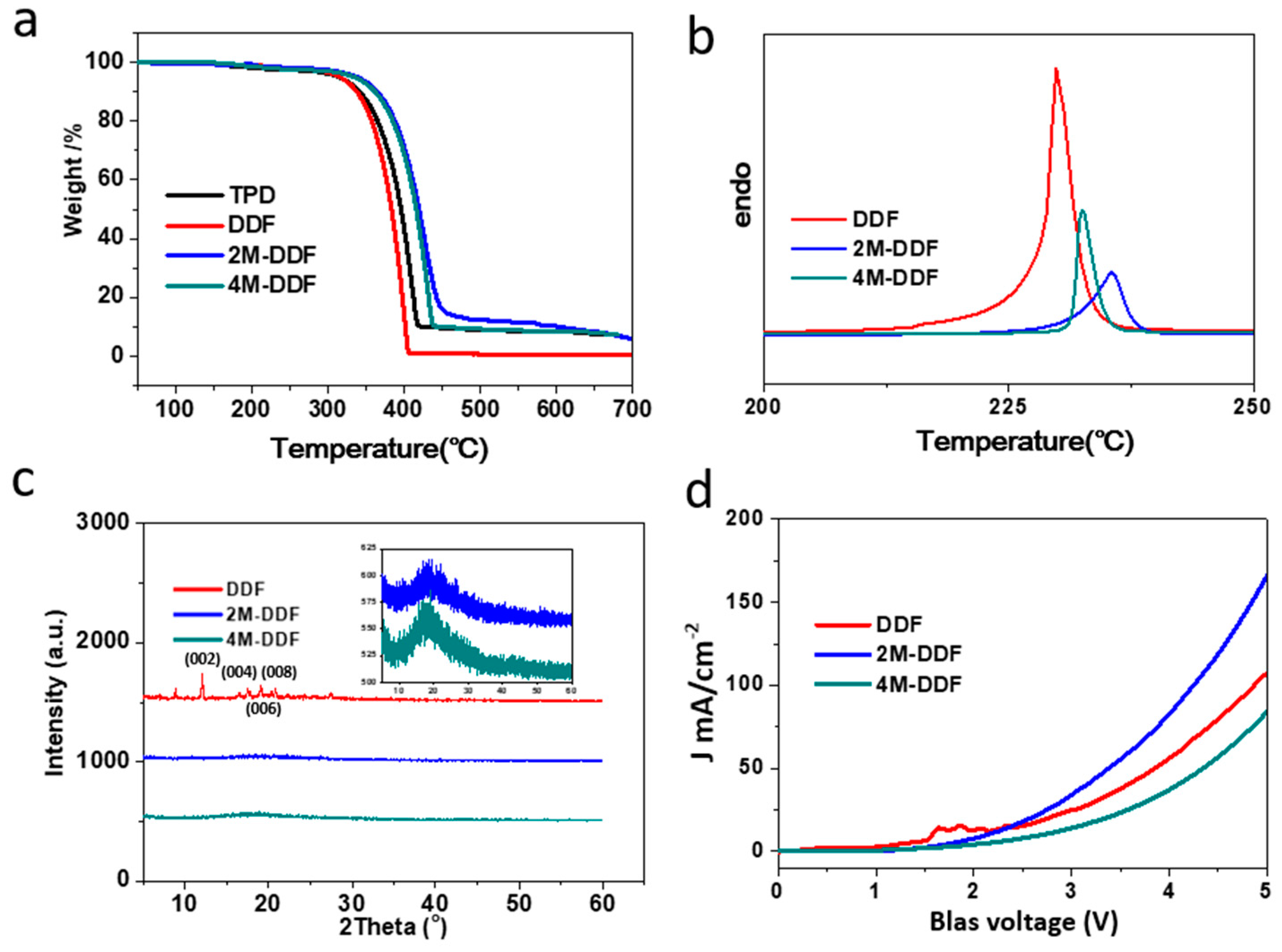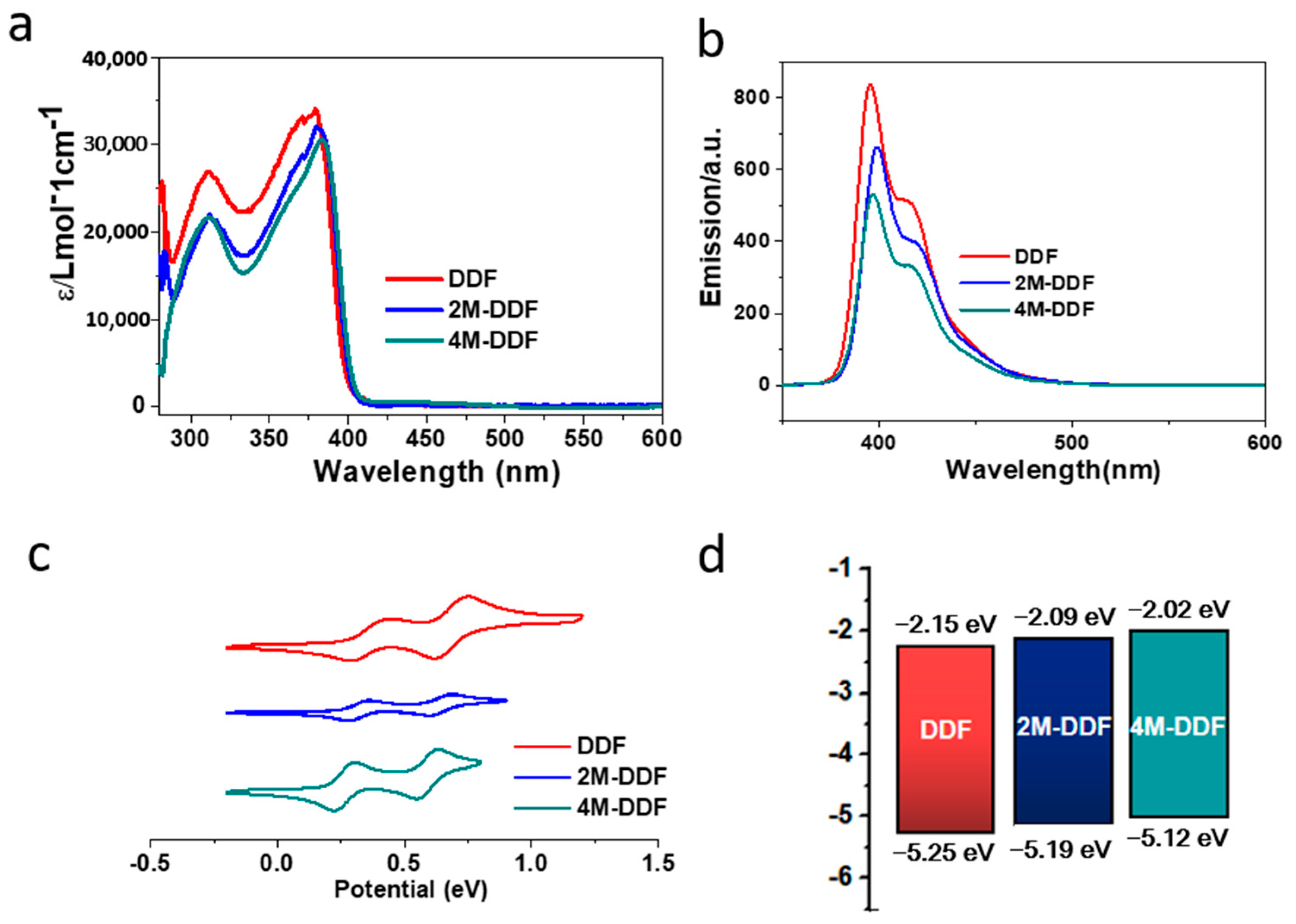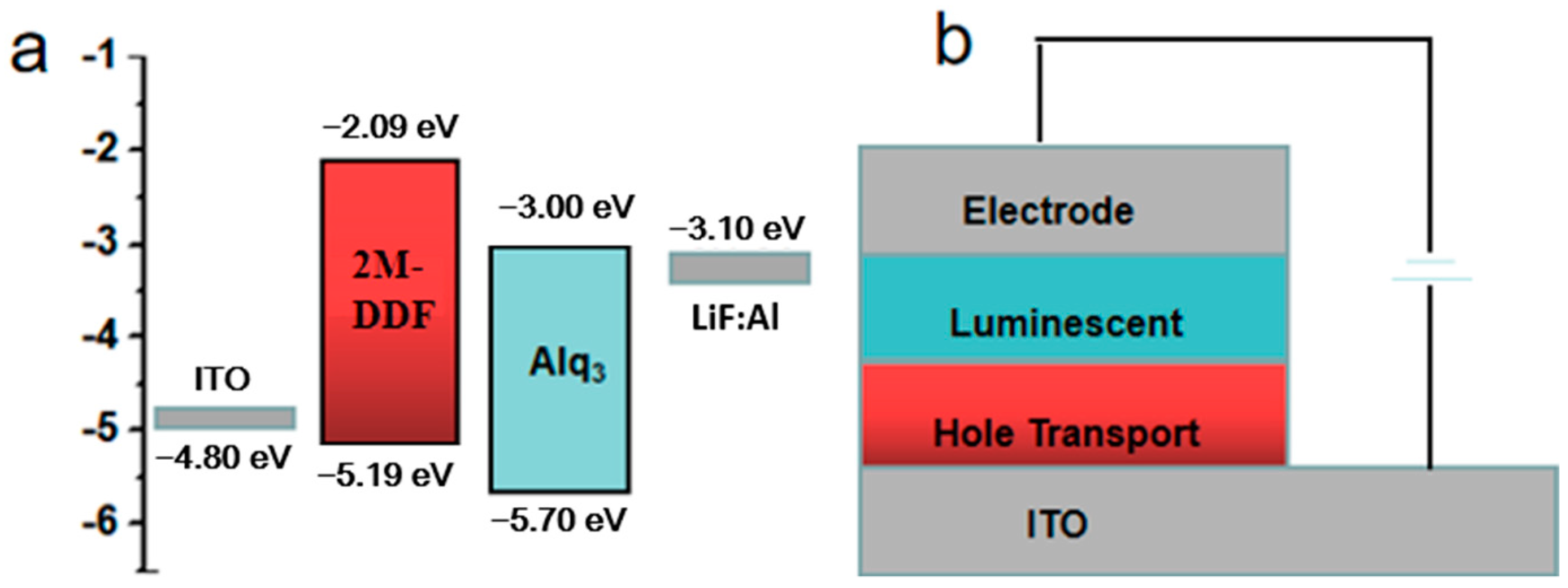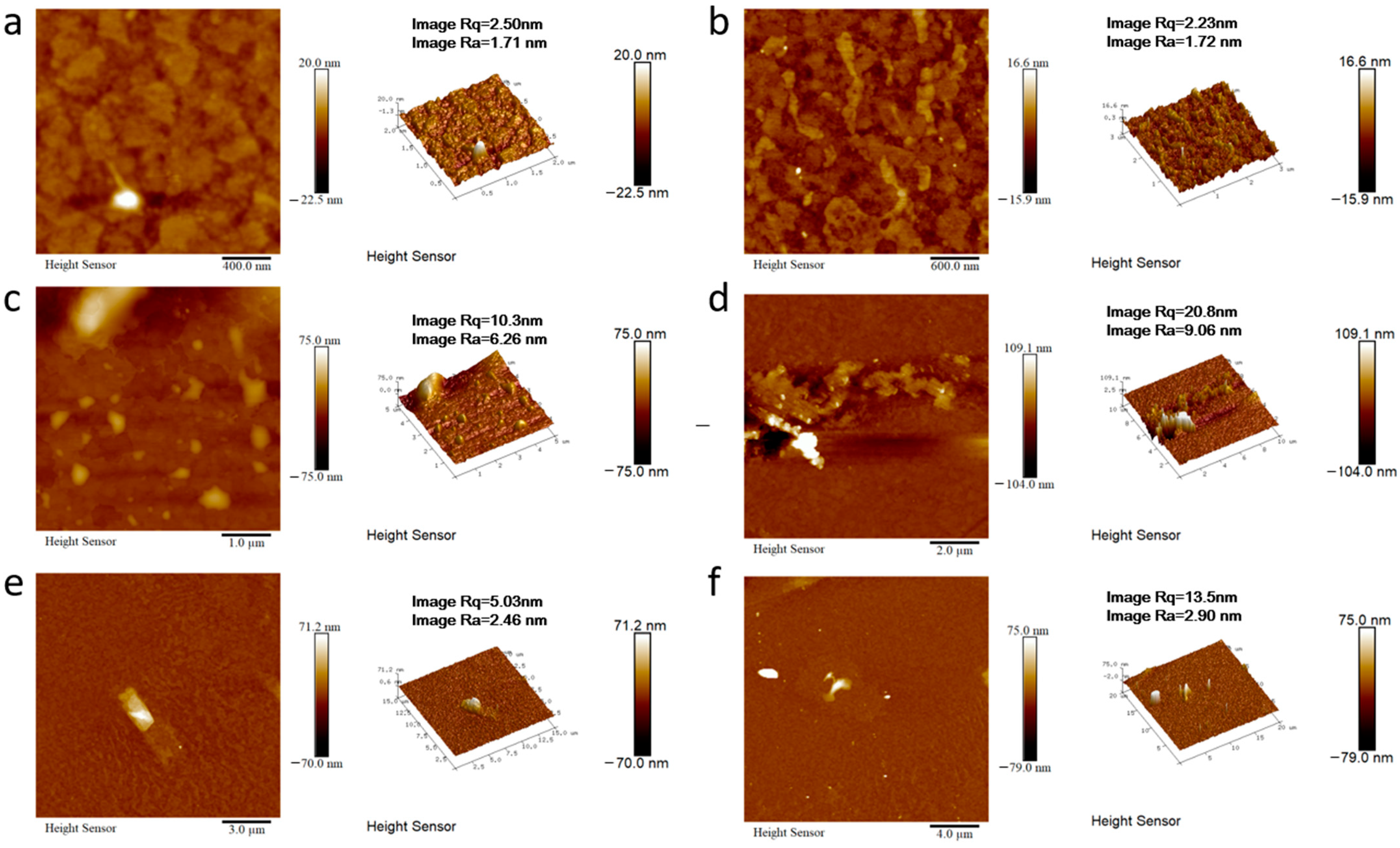Hole-Transporting Materials Based on a Fluorene Unit for Efficient Optoelectronic Devices
Abstract
:1. Introduction
2. Results and Discussion
2.1. Fluorene-Based Amorphous Compounds with Good Solubility and High Thermal Stability Facilitate the Preparation of Flexible Films via Solution-Processable Materials Methods
2.2. Superior Electrochemical Properties of Fluorene Compounds Facilitate Hole Injection and Hence the Carrier-Transport Efficiency
2.3. Superior Carrier-Transport Performance and High Energy Level Greatly Improve the Luminous Efficiency of OLED Devices
3. Conclusions
Supplementary Materials
Author Contributions
Funding
Institutional Review Board Statement
Informed Consent Statement
Data Availability Statement
Conflicts of Interest
References
- Chen, Z.-Y.; Chen, Z.; Zhu, Y.-Q.; Zhuo, M.-Z.; Yang, G.-Y.; Wang, X.-H.; Wu, M.-X. Ultralong Blue Organic Room-Temperature Phosphorescence Promoted by Green Assembly. Adv. Funct. Mater. 2024, 2408023. [Google Scholar] [CrossRef]
- Zhou, X.L.; Zhao, X.; Bai, X.; Cheng, Q.W.; Liu, Y. Thermal Activated Reversible Phosphorescence Behavior of Solid Supramolecule Mediated by β-Cyclodextrin. Adv. Funct. Mater. 2024, 34, 2400898. [Google Scholar] [CrossRef]
- Cui, J.Y.; Ali, S.H.; Shen, Z.Y.; Xu, W.S.; Liu, J.Y.; Li, P.X.; Li, Y.; Chen, L.G.; Wang, B.W. 3-Polylysine organic ultra-long room-temperature phosphorescent materials based on phosphorescent molecule doping. Chem. Sci. 2024, 15, 4171. [Google Scholar] [CrossRef] [PubMed]
- Guo, W.-J.; Yan, S.R.; Chen, L.; Qiao, L.; Xu, S.H.; Qi, T.F.; Liu, B.; Peng, H.Q. Isomeric Engineering of Organic Luminophores for Multicolor Room Temperature Phosphorescence Including Red Afterglow. Adv. Funct. Mater. 2024, 2406888. [Google Scholar] [CrossRef]
- Chen, J.W.; Zhang, S.G.; Liu, G.Y.; Zhang, Y.F.; Xue, S.F.; Sun, Q.K.; Yang, W.J. Regulating Organic Dopant Dispersion in Polymer Matrices for Concentration-Controlled Color-Tunable Organic RTP Emissions. Adv. Opt. Mater. 2023, 11, 2301163. [Google Scholar] [CrossRef]
- Zhou, Q.; Liu, Y.X.; Ma, X.R.; Fan, W.W.; Cheng, Y.; He, R.Y.; Meng, X.; Shi, Y.G.; Cao, Q.; Zheng, L.Y. Luminophore with Multiple Emission Centers for Fluorescence/Phosphorescence Dual Ratiometric Chemical Sensing in Aqueous Solution. Adv. Opt. Mater. 2024, 12, 2303107. [Google Scholar] [CrossRef]
- Zhang, X.H.; Chong, K.C.; Xie, Z.L.; Liu, B. Color-tunable dual-mode organic afterglow for white-light emission and information encryption based on carbazole doping. Angew. Chem. Int. Ed. 2023, 62, e202310335. [Google Scholar] [CrossRef] [PubMed]
- Liang, Y.H.; Hu, P.T.; Zhang, H.Q.; Yang, Q.C.; Wei, H.S.; Chen, R.T.; Yu, J.H.; Liu, C.; Wang, Y.H.; Luo, S.L.; et al. Enabling Highly Robust Full-Color Ultralong Room-Temperature Phosphorescence and Stable White Organic Afterglow from Polycyclic Aromatic Hydrocarbons. Chem. Int. Ed. 2024, 63, e202318516. [Google Scholar] [CrossRef]
- Qiao, W.G.; Yao, M.; Xu, J.W.; Peng, H.Y.; Xia, J.L.; Xie, X.L.; Li, Z.A. Naphthyl Substituted Impurities Induce Efficient Room Temperature Phosphorescence. Angew. Chem. 2023, 135, e202315911. [Google Scholar] [CrossRef]
- Jang, E.; Jang, H. Quantum dot light-emitting diodes. R Chem. Rev. 2023, 123, 4663–4692. [Google Scholar] [CrossRef]
- Kim, J.H.; Han, S.H.; Lee, J.Y. Concentration quenching resistant donor-acceptor molecular structure for high efficiency and long lifetime thermally activated delayed fluorescent organic light-emitting diodes via suppressed non-radiative channel. Chem. Eng. J. 2020, 395, 125159. [Google Scholar] [CrossRef]
- Chen, J.; Song, D.; Zhao, S.; Qiao, B.; Zheng, W.; Xu, Z. Highly efficient all-solution processed blue quantum dot light-emitting diodes based on balanced charge injection achieved by double hole transport layers. Org. Electron. 2021, 94, 106169. [Google Scholar] [CrossRef]
- Wang, W.; Wu, Z.; Ye, T.; Ding, S.; Wang, K.; Peng, Z.; Sun, X.W. High-performance perovskite light-emitting diodes based on double hole transport layers. J. Mater. Chem. C 2021, 9, 2115. [Google Scholar] [CrossRef]
- Zhong, Z.; Quan, H.; Zhang, J.; Peng, F.; Zhong, W.; Ying, L. Improving the Performance of Quantum Dot Light-Emitting Diodes by the Enrichment of a Fluorinated Component on Top of a Hole Transport Layer. ACS Appl. Electron. Mater. 2023, 5, 6452–6458. [Google Scholar] [CrossRef]
- Su, H.; Xu, Z.; He, X.; Yao, Y.; Zheng, X.; She, Y.; Zhu, Y.; Zhang, J.; Liu, S.F. Surface energy engineering of buried interface for highly stable perovskite solar cells with efficiency over 25%. Adv. Mater. 2024, 36, 2306724. [Google Scholar] [CrossRef]
- Liu, C.; Yang, T.; Cai, W.; Wang, Y.; Chen, X.; Wang, S.; Huang, W.; Du, Y.; Wu, N.; Wang, Z.; et al. Flexible Indoor Perovskite Solar Cells by In Situ Bottom-Up Crystallization Modulation and Interfacial Passivation. Adv. Mater. 2024, 36, 2311562. [Google Scholar] [CrossRef]
- Shen, L.; Song, P.; Zheng, L.; Wang, L.; Zhang, X.; Liu, K.; Liang, Y.; Tian, W.; Luo, Y.; Qiu, J.; et al. Ion-Diffusion Management Enables All-Interface Defect Passivation of Perovskite Solar Cells. Adv. Mater. 2023, 35, 2301624. [Google Scholar] [CrossRef] [PubMed]
- Sun, Q.; Meng, X.; Liu, G.; Duan, S.; Hu, D.; Shen, B.; Kang, B.; Silva, S.R.P. SnO2 Surface Modification and Perovskite Buried Interface Passivation by 2, 5-Furandicarboxylic Acid for Flexible Perovskite Solar Cells. Adv. Funct. Mater. 2024, 2404686. [Google Scholar] [CrossRef]
- Liu, B.; Zhou, Q.; Li, Y.; Chen, Y.; He, D.; Ma, D.; Han, X.; Li, R.; Yang, K.; Yang, Y.; et al. Polydentate Ligand Reinforced Chelating to Stabilize Buried Interface toward High-Performance Perovskite Solar Cells. Angew. Chem. Int. Ed. 2024, 63, e202317185. [Google Scholar] [CrossRef]
- Salehi, A.; Fu, X.; Shin, D.H.; So, F. Recent advances in OLED optical design. Adv. Funct. Mater. 2019, 29, 1808803. [Google Scholar] [CrossRef]
- Song, X.; Zhang, D.; Lu, Y.; Yin, C.; Duan, L. Understanding and Manipulating the Interplay of Wide-Energy-Gap Host and TADF Sensitizer in High-Performance Fluorescence OLEDs. Adv. Mater. 2019, 31, 1901923. [Google Scholar] [CrossRef] [PubMed]
- Xu, R.; Pan, F.; Chen, J.; Li, J.; Yang, Y.; Sun, Y.; Zhu, X.; Li, P.; Cao, X.; Xi, J.; et al. Optimizing the Buried Interface in Flexible Perovskite Solar Cells to Achieve Over 24% Efficiency and Long-Term Stability. Adv. Mater. 2024, 36, 2308039. [Google Scholar] [CrossRef] [PubMed]
- Zeng, J.; Li, Y.; Fan, X.J. Significant breakthroughs in interface engineering for high-performance colloidal OLEDs: A mini review. Phys. D Appl. Phys. 2023, 56, 343001. [Google Scholar] [CrossRef]
- Tsai, K.W.; Hung, M.K.; Mao, Y.H.; Chen, S.A. Solution—Processed thermally activated delayed fluorescent OLED with high EQE as 31% using high triplet energy crosslinkable hole transport materials. Adv. Funct. Mater. 2019, 29, 1901025. [Google Scholar] [CrossRef]
- Zhang, X.; Li, D.; Zhang, Z.; Liu, H.; Wang, S. Constructing Effective Hole Transport Channels in Cross-Linked Hole Transport Layer by Stacking Discotic Molecules for High Performance Deep Blue QLEDs. Adv. Sci. 2022, 9, 2200450. [Google Scholar] [CrossRef] [PubMed]
- Krucaite, G.; Volyniuk, D.; Simokaitiene, J.; Grigalevicius, S.; Linb, C.H.; Shao, C.M.; Chang, C.H. Naphthyl substituted triphenylamine derivatives as hole transporting materials for efficient red PhOLEDs. Dye. Pigment. 2019, 162, 196–202. [Google Scholar] [CrossRef]
- Li, X.; Cui, J.; Ba, Q.; Zhang, Z.; Chen, S.; Yin, G.; Wang, Y.; Li, B.; Xiang, G.; Kim, K.S.; et al. Multiphotoluminescence from a Triphenylamine Derivative and Its Application in White Organic Light-Emitting Diodes Based on a Single Emissive Layer. Adv. Mater. 2019, 31, 1900613. [Google Scholar] [CrossRef]
- Braveenth, R.; Bae, I.J.; Wang, Y.; Kim, S.H.; Kim, M.; Chai, K.Y. Acridine-Triphenylamine Based Hole-Transporting and Hole-Injecting Material for Highly Efficient Phosphorescent-Based Organic Light Emitting Diodes. Appl. Sci. 2018, 8, 1168. [Google Scholar] [CrossRef]
- Zhou, G.; Wong, W.Y.; Yao, B.; Xie, Z.; Wang, L. Triphenylamine-dendronized pure red iridium phosphors with superior OLED efficiency/color purity trade-offs. Angew. Chem. Int. Ed. 2007, 46, 1149–1151. [Google Scholar] [CrossRef]
- Tao, Y.; Wang, Q.; Shang, Y.; Yang, C.; Ao, L.; Qin, J.; Ma, D.; Shuai, Z. Multifunctional bipolar triphenylamine/oxadiazole derivatives: Highly efficient blue fluorescence, red phosphorescence host and two-color based white OLEDs. Chem. Commun. 2009, 77–79. [Google Scholar] [CrossRef]
- Peng, Z.; Zhang, K.; Huang, Z.; Wang, Z.; Duttwyler, S.; Wang, Y.; Lu, P.J. Emissions from a triphenylamine–benzothiadiazole–monocarbaborane triad and its applications as a fluorescent chemosensor and a white OLED component. Mater. Chem. C 2019, 7, 2430–2435. [Google Scholar] [CrossRef]
- Braveenth, R.; Bae, I.J.; Han, J.H.; Qiong, W.; Seon, G.; Raagulan, K.; Yang, K.; Park, Y.H.; Kim, M.; Chai, K.Y. Utilizing a Spiro Core with Acridine- and Phenothiazine-Based New Hole Transporting Materials for Highly Efficient Green Phosphorescent Organic Light-Emitting Diodes. Molecules 2018, 23, 713. [Google Scholar] [CrossRef] [PubMed]
- Fang, Q.; Xu, B.; Jiang, B.; Fu, H.; Zhu, W.; Jiang, X.; Zhang, Z. A novel fluorene derivative containing four triphenylamine groups: Highly thermostable blue emitter with hole-transporting ability for organic light-emitting diode (OLED). Synth. Met. 2005, 155, 206–210. [Google Scholar] [CrossRef]
- Gmelch, M.; Thomas, H.; Fries, F.; Reineke, S. Programmable transparent organic luminescent tags. Sci. Adv. 2019, 5, 7310. [Google Scholar] [CrossRef] [PubMed]
- Ibrahim-Ouali, M.; Dumur, F. Recent advances on metal-based near-infrared and infrared emitting OLEDs. Molecules 2019, 24, 1412. [Google Scholar] [CrossRef] [PubMed]
- Deng, G.; Feng, Q.; Yang, M.; Wang, Q.; Xu, H.; Liu, J.; Bo, S.; Zhang, X.L.; Li, Z.H. Synthesis and properties study of a X-type dendrimer based on triphenylamine. Mater. Lett. 2017, 193, 112–114. [Google Scholar] [CrossRef]
- Li, W.; Liu, B.; Sun, M.J. Synthesis of 4, 5-diazofluorene photoelectric materials the application of thin film devices. Nanjing Univ. Posts Telecommun. Nat. Sci. 2013, 33, 1673–5439. (In Chinese) [Google Scholar]
- Luo, X.; Chang, G.; Zhang, L. Synthesis and characterization of polyimidone containing fluorine. Chin. J. Synth. Chem. 2009, 17, 15–18. (In Chinese) [Google Scholar]
- Wua, S.; Liua, H.; Suna, W.; Lia, X.; Wang, S. Regulation of peripheral tert-butyl position: Approaching efficient blue OLEDs based on solution-processable hole-transporting materials. Org. Electron. 2019, 71, 85–92. [Google Scholar] [CrossRef]
- Cho, Y.J.; Yook, K.S.; Lee, J.Y. High Efficiency in a Solution-Processed Thermally Activated Delayed-Fluorescence Device Using a Delayed-Fluorescence Emitting Material with Improved Solubility. Adv. Mater. 2014, 26, 6642–6646. [Google Scholar] [CrossRef] [PubMed]
- Ayobi, A.; Mirnia, S.N.; Rezaee Roknabadi, M.; Bahari, A. The effects of MoO3/TPD multiple quantum well structures on the performance of organic light emitting diodes (OLEDs). J. Mater. Sci. Mater. Electron. 2019, 30, 3952–3958. [Google Scholar] [CrossRef]
- Bian, M.Y.; Zhang, D.D.; Wang, Y.X.; Chung, Y.H.; Liu, Y.; Ting, H.; Duan, L.; Chen, Z.J.; Bian, Z.Q.; Liu, Z.W.; et al. Long—Lived and Highly Efficient TADF—PhOLED with “(A) n-D-(A) n” Structured Terpyridine Electron—Transporting Material. Adv. Funct. Mater. 2018, 28, 1800429. [Google Scholar] [CrossRef]
- Wang, T.; Weerasinghe, K.C.; Liu, D.; Li, W.; Yan, X.; Zhou, X.; Wang, L. Ambipolar organic semiconductors with cascades of energy levels for generating long-lived charge separated states: A donor–acceptor1–acceptor2 architectural triarylamine dye. J. Mater. Chem. C 2014, 2, 5466–5470. [Google Scholar] [CrossRef]
- Sun, H.; Li, P.; Liu, D.; Wang, T.; Li, W.; Hu, W.; Wang, L.; Zhou, X. Tuning photophysical properties via alkoxyl groups in charge-separated triphenylamine sensitizers for dye-sensitized solar cells. J. Photochem. Photobiol. A Chem. 2019, 368, 233–241. [Google Scholar] [CrossRef]
- Shang, Z.; Liu, D.; Wang, T.; Yu, X.; Li, B.; Li, W.; Hu, W.; Zhou, X. Enhanced Hole-Injection Property in an OLED with a Self-assembled Monolayer of Hole-Transporting TPD on Thin Au as the Anode. Trans. Tianjin Univ. 2018, 24, 580–586. [Google Scholar] [CrossRef]
- Zhang, S.; Feng, W.L.W.; Wang, T.; Liu, D.; Zhou, X. Synthesis and Properties of a Novel Triphenylamine Hole Transport Material. Chem. Ind. Eng. 2020, 37, 3. [Google Scholar]
- Wei, Q.; Fei, N.; Islam, A.; Lei, T.; Hong, L.; Peng, R.; Fan, X.; Chen, L.; Gao, P.; Ge, Z. Small-molecule emitters with high quantum efficiency: Mechanisms, structures, and applications in OLED devices. Adv. Opt. Mater. 2018, 6, 1800512. [Google Scholar] [CrossRef]
- Jankus, V.; Data, P.; Graves, D.; McGuinness, C.; Santos, J.; Bryce, M.R.; Dias, F.B.; Monkman, A.P. Highly efficient TADF OLEDs: How the emitter–host interaction controls both the excited state species and electrical properties of the devices to achieve near 100% triplet harvesting and high efficiency. Adv. Funct. Mater. 2014, 24, 6178–6186. [Google Scholar] [CrossRef]
- Duan, L.; Qiao, J.; Sun, Y.; Qiu, Y. Strategies to design bipolar small molecules for OLEDs: Donor—Acceptor structure and non-donor—Acceptor structure. Adv. Mater. 2011, 23, 1137–1144. [Google Scholar] [CrossRef]
- Song, J.W.; Muleta, D.Y.; Feng, W.H.; Song, Y.K.; Zhou, X.Q.; Li, W.; Wang, L.C.; Liu, D.Z.; Wang, T.Y.; Hu, W. Photophysical tuning of small-molecule-doped organic crystals with long-persistent luminescence by variation of dopants. Dye. Pigment. 2021, 193, 109501. [Google Scholar] [CrossRef]
- Han, J.; Feng, W.; Muleta, D.Y.; Bridgmohan, C.N.; Dang, Y.; Xie, G.; Zhang, H.; Zhou, X.; Li, W.; Wang, L.; et al. Small-molecule—Doped organic crystals with long—Persistent luminescence. Adv. Funct. Mater. 2019, 29, 1902503. [Google Scholar] [CrossRef]
- Wang, T.; Liu, M.; Feng, W.; Cao, R.; Sun, Y.; Wang, L.; Liu, D.; Wang, Y.; Wang, T.; Hu, W. Long-Lived Charge Separation Induced Organic Long—Persistent Luminescence with Circularly Polarized Characteristic. Adv. Opt. Mater. 2023, 11, 2202613. [Google Scholar] [CrossRef]
- Zhang, Z.; Wang, Q.; Zhang, X.; Mei, J.; Tian, H. Multimode Stimuli-Responsive Room-Temperature Phosphorescence Achieved by Doping Butterfly-like Fluorogensinto Crystalline Small-Molecular Hosts. JACS Au 2024, 4, 1954–1965. [Google Scholar] [CrossRef] [PubMed]
- Jacak, J.E.; Jacak, W.A. Routes for metallization of perovskite solar cells. Materials 2022, 15, 2254. [Google Scholar] [CrossRef] [PubMed]
- Luo, C.; Gao, F.; Wang, X.; Zhan, C.; Zhang, X.; Zheng, G.; Zhang, X.; Gao, X.; He, Z.; Zhao, Q. Eliminating performance loss from perovskite films to solar cells. Sci. Adv. 2024, 10, eadp0790. [Google Scholar] [CrossRef] [PubMed]
- Chen, H.; Liu, C.; Xu, J.; Maxwell, A.; Zhou, W.; Yang, Y.; Zhou, Q.; Bati, A.S.R.; Wan, H.; Wang, Z.; et al. Improved charge extraction in inverted perovskite solar cells with dual-site-binding ligands. Science 2024, 384, 189–193. [Google Scholar] [CrossRef] [PubMed]







| Compound | Von a (V) | CE b (cd/A) | PE c (lm/W) | Lmax d (cd/cm−2) |
|---|---|---|---|---|
| TPD [45] | 4.3 | 3.70 | 15 | 4106 |
| TFB only [12] | 2.4 | 2.90 | 15,211 | |
| PVK only [12] | 3.4 | 1.10 | 2288.9 | |
| TFB/PVK [13] | 7.4 | 5.35 | 10,520 | |
| 2M-DDF [46] | 3.8 | 4.78 | 16 | 21,412 |
| No. | Host | Guest | Processing Technique | Time | Afterglow Color | Ref. |
|---|---|---|---|---|---|---|
| 1 | 9H-carbazole | 9H-carbazole | crystallization | 2 s | Orange | [50] |
| 2 | 2,8-bis(diphenylphosphoryl)dibenzo[b,d] | 2,7-di-(N,N-diphenylamino) 9,9-dimethyl-9H-fluorene | crystallization | 6 s | Blue | [51] |
| 3 | PMMA:TPP | (R)-1,1′-Bi-2 naphthylamine | heat | 10 s | Blue | [52] |
| 4 | triphenylphosphine | N,N′-diphenyl-dihydrodibenzo [a,c]phenazine derivatives | crystallization | 3 s | Blue | [53] |
Disclaimer/Publisher’s Note: The statements, opinions and data contained in all publications are solely those of the individual author(s) and contributor(s) and not of MDPI and/or the editor(s). MDPI and/or the editor(s) disclaim responsibility for any injury to people or property resulting from any ideas, methods, instructions or products referred to in the content. |
© 2024 by the authors. Licensee MDPI, Basel, Switzerland. This article is an open access article distributed under the terms and conditions of the Creative Commons Attribution (CC BY) license (https://creativecommons.org/licenses/by/4.0/).
Share and Cite
Man, M.; Zhao, M.; Lyu, Y. Hole-Transporting Materials Based on a Fluorene Unit for Efficient Optoelectronic Devices. Materials 2024, 17, 5417. https://doi.org/10.3390/ma17225417
Man M, Zhao M, Lyu Y. Hole-Transporting Materials Based on a Fluorene Unit for Efficient Optoelectronic Devices. Materials. 2024; 17(22):5417. https://doi.org/10.3390/ma17225417
Chicago/Turabian StyleMan, Maoli, Mingming Zhao, and Yunfei Lyu. 2024. "Hole-Transporting Materials Based on a Fluorene Unit for Efficient Optoelectronic Devices" Materials 17, no. 22: 5417. https://doi.org/10.3390/ma17225417
APA StyleMan, M., Zhao, M., & Lyu, Y. (2024). Hole-Transporting Materials Based on a Fluorene Unit for Efficient Optoelectronic Devices. Materials, 17(22), 5417. https://doi.org/10.3390/ma17225417






